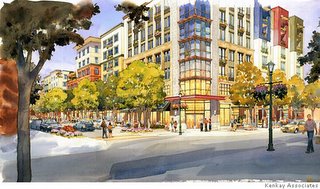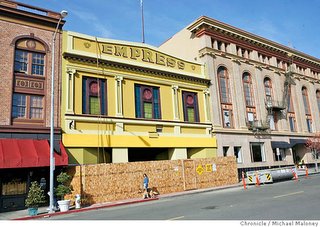Vallejo Leaders Are Hoping to Turn Their City's Potential Into Prominence
Dana Perrigan, Special to The Chronicle
Sunday, July 9, 2006


This corner shows how downtown Vallejo is expected to be renovated as part of a $500 million, 15-year project. Illustration courtesy of Kenkay Associates
On a warm afternoon in downtown Vallejo, workers inside the Empress Theatre on Virginia Street labor with a focused intensity to resurrect the 94-year-old Beaux Arts-style movie house in time for its anticipated reopening in early 2007.
Here, surrounded by sea-blue walls festooned with gilded golden clouds and scalloped scrollwork, generations of residents watched popular films of the day from the comfort of red velvet seats. In 1915, the big hit was D.W. Griffith's epic "Birth of a Nation."
But if the theater's marquee -- dark since the Loma Prieta earthquake of 1989 -- were to announce to residents what the civic leaders of today envision as the coming attraction, it would read: "Rebirth of a City."
The $4.7 million renovation of the Empress into a multi-purpose, 500-seat performing arts theater is just the opening credits.
Later this summer, ground will be broken in the parking lot across the street from the theater, signaling the first phase of an ambitious $500 million, 15-year project designed to transform downtown Vallejo into the vibrant and thriving center it once was.
"Vallejo is this diamond in the rough," says Vallejo City Councilwoman Stephanie Gomes. "You hear the 'P' word used a lot; we've got 'potential.' Well, we're tired of hearing that."
If all goes according to plan -- a plan, nearly three years in the making that was approved by citizen committees and the City Council in January -- Vallejo residents won't have to hear it much longer. Under the terms of the partnership between the city and Seattle developer Triad Communities, 12 square blocks adjacent to the town's historic waterfront will be redeveloped.
Seven buildings, containing 100,000 square feet of office and retail space on the ground floors with about 1,000 residential units -- including studio lofts, live-work townhouses, one- and two-bedroom flats and penthouses above -- will be built. All are designed to have common areas, rooftop gardens, European-style paseos and courtyards. All are designed to receive Leadership in Energy and Environmental Design certification.
Architectural renderings by design firm GGLO of Sacramento show attractive, pedestrian-friendly, tree-lined streets with brick and granite sidewalks made for sauntering, canopied restaurant fronts with alfresco dining, fruit-market stalls, prominently paved mid-block crossings, flower beds bordered by iron railings, pedestrian-scale lighting, diagonal parking and other traffic-slowing devices.
Streets that have been cut off from the waterfront by previous development will be reconnected. Anchored by the Empress, an arts and entertainment district and office/employment and retail districts are planned.
And since the plan is expected to attract enough people who want to live, work and shop in the area to create a viable retail base, transportation is crucial. The city intends, by linking its ferry service with buses and BART, to create a transportation hub.
"If I were a young person looking at places to live in the Bay Area, a place where I could own something as I was starting out, I would seriously consider Vallejo," says Mayor Tony Intintoli. "To have a home here in Vallejo for $350,000 or so versus $750,000 in San Francisco would be an attractive alternative."
Intintoli is convinced that the downtown revival -- coupled with the town's sunny, temperate climate, historic architecture and location -- will spark a boom of the sort other Bay Area cities have experienced.
Five years ago, during a trip to Seattle to inspect the city's ferry service, the mayor decided to visit Triad executives. Triad had recently developed Hiddenbrooke Valley -- 2,400 homes, along with Hiddenbrooke Golf Club in Vallejo. He had been impressed with what he had seen of Triad's downtown developments in Seattle, which included transforming a dilapidated pier and 19th-century warehouse into high-tech offices.
"So they had a lot of experience with infill development," Intintoli says. "In that context, I said, 'you really should look at downtown Vallejo. We have an area which is centrally located, an expanding ferry service and an attractive historic area -- and we have this downtown that has gone nowhere.' "
When Triad's executive vice president Curt Johansen accepted the mayor's invitation, he liked what he saw.
"It has a lot of what we call good DNA," says Johansen. "They didn't get rid of the alleys. The grid was intact."
Johansen also liked the old buildings, but he noticed that, scattered throughout the downtown area, there were gaps, like missing teeth, where buildings had been removed. In their place were parking lots, sparsely used in the languishing town center.
"The bad news is that they tore the buildings down and put in parking lots," says Johansen. "The good news is that they didn't sell the land. When I finally realized what was troubling me, I said, 'Can I put the buildings back?' "
Under the terms of Triad's agreement with Vallejo, the city will sell the parking lots to Triad, says the city's downtown economic director, Craig Whittom. Triad will manage the retail space in its buildings and sell the residential units. The city will spend $10 million over the plan's two phases on infrastructure and other improvements.
"We are also committed to funding some business development and marketing," says Whittom. Working closely with the city and the Downtown Advisory Group, Triad, in its role as master developer, presented its plans three years later. The specific plan and design guidelines recently received awards from the American Planning Association.
"I think the Downtown Advisory Group was key to quickly getting approval," says Councilwoman Gomes. "Involving the community in a development plan is crucial. They (developers) don't know the town's warts and cracks like the people who live here do. And it's important that everyone has a stake in it."
Two years ago, Steve Bode bought a stake in downtown Vallejo when he purchased the building -- a restaurant with 14 apartments above it -- next to the Empress Theatre. The Sausalito resident had been looking for investment property in Marin, but most of what he found there he considered overpriced.
"Vallejo is kind of an ignored place," Bode says. "It's got all these great possibilities, but it has this stigma, a high crime rate, to it."
Despite the stigma, Bode says, property values have risen 50 percent during the last two years. And he expects more of the same as a result of the downtown redevelopment.
"I feel like I'm getting in on the beginning of a boom," he says. "And I think there's gonna be more opportunity here in the future."
He isn't alone.
"This is a very ambitious plan," Intintoli says. "It's a very exciting time here in Vallejo."
E-mail Dana Perrigan at perrigan2000@yahoo.com.

The Empress Theatre has been around for nearly a century, and now is being renovated for an expected reopening early next year. Chronicle photo by Michael Maloney

The Empress Theatre has been around for nearly a century, and now is being renovated for an expected reopening early next year. Illustration courtesy of Kenkay Associates
